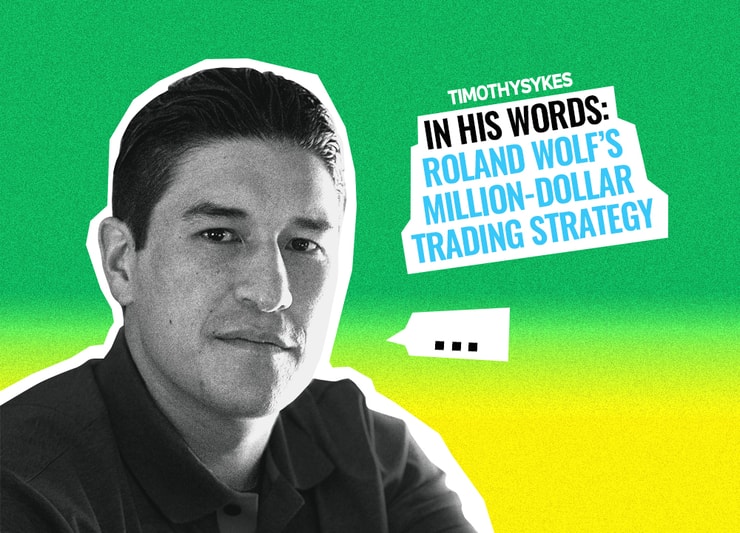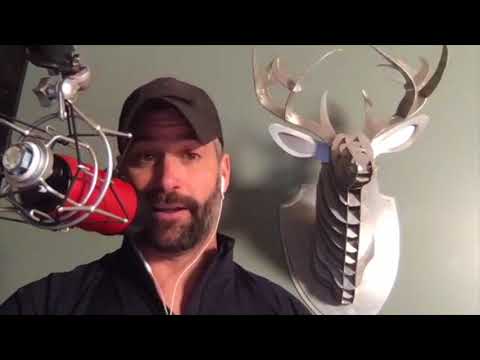Finding a consistent penny stock trading strategy is how many of my top Challenge students became successful…
It’s not easy to do. And when one of my students makes it to the seven-figure profit club, it’s a big deal to me…
So help me congratulate my newest millionaire Challenge student, Roland Wolf!*
I’m so proud of Roland’s accomplishments. And to celebrate, I flew him to Miami on a private jet to catch up with him. I wanted to understand how he turned his $4,000 trading account into over $1 million in four years.*
Roland talked me through the trading strategy he uses to average $1K per day.*
Enough of me hyping up my newest millionaire student — you can hear about his success directly from him.
This is Roland. I couldn’t be prouder of his success. Here’s his story, in his words…
(*Trading is inherently risky. Roland’s results are not typical. It takes dedication and years of studying to find consistency in the penny stock market. Individual results will vary. Never trade with more money than you can afford to lose.)
Table of Contents
My Beginnings

Becoming a million-dollar Challenge student is one of my proudest professional achievements to date, but it didn’t come easy.
In fact, one of the hardest parts was balancing a family with my wife and three children — all while studying over 17 hours per day on a regular basis.
But I want to serve as living proof that anyone can do this. You don’t need to be a genius to make it in the penny stock market.
You don’t need to be young with all the time in the world either. Sure, I wish I’d gotten into trading when I was younger. But the fact is, I still made it happen.
What you need is a mentor who’ll teach you the ropes and a work ethic like none other. If you think you can be a million-dollar Challenge student without putting in the work, you’re in for a rude awakening.
Ready to learn how Tim Sykes taught me to become a millionaire penny stock trader? Please, read on.
I’ll cover my story and the trading strategy I learned, which I now use to make an average of $1,000 a day.*
Why Did I Start Trading?
I got into this game like so many others. I wanted a side hustle where I could make extra cash. At the time, my second child was born. It was debatably the sole reason for my desire to become a successful trader…
I wanted a better life for my family.
It’s not that I had a bad job before. In fact, I had a nice gig going at my family’s business. And I was getting ready to go to law school. Again, my desire to provide a better life for my family drove all of these decisions.
As luck had it, I found trading instead. Now, I’ll be honest…
At the time, I thought I’d use trading as a way to make some quick side money — maybe to pay for law school or to help with the bills.
I never thought it’d turn into my full-time career.
But I also never realized how much work it would really take to end up averaging $1K per day.* Day trading is the furthest thing from a get-rich-quick scheme.
Now, four years into my journey, I feel like I’m just getting started. Even after crossing $1 million in trading profits.
I take each day as it comes to me — why force a trade to try and make more? It’s just not part of my strategy. I want to talk about how I got to the trading strategy I use today. It’s taken me years to refine it…
The Strategies I Used as a New Trader
A lot of people think we successful traders have some gene that makes us better in the markets…
That’s not the case. In fact, when I first started, my penny stock trading strategy was the exact opposite of what I should have been doing…
I chased alerts from Sykes.
Yep, I know. One of the first things Sykes tells all of his students is to never follow his alerts. His alerts are there so you can learn, not blindly follow him.
But I was new. I thought trading would be an easy way to make money. So following Sykes sounded like the perfect plan…
It actually worked for the first trade. That might have been the worst thing that could have happened to me at that point. It let me believe that following alerts would help me make a ton of money.
Well, the next 10 trades in a row were losers. Yep, it took me losing 10 more trades to realize that following alerts doesn’t work.
That’s when I knew I needed to buckle down and study. And that’s…
How I Found Consistency and My Penny Stock Trading Strategy
Obviously, I wasn’t a consistent trader right away. It took a lot of studying for me to hit my stride.
I was a long-biased trader. So I knew long trading strategies would suit me better.
Pro tip: I always recommend new traders learn to long first…
But finding consistency is about more than just finding a solid strategy. Every strategy and pattern that Tim teaches can work — it’s about finding one that works for you.
From there, it’s all about the work you put in. And for me, it’s…
More Breaking News
- Nestlé Stock Rises on the Back of Analyst Confidence: Is It the Time to Dive In?
- Is It Time to Rethink IONQ Stock After Recent Market Dip?
- Is ChargePoint’s Dip a Signal to Buy or Stay Away?
What Separates Me From Other Students
I think the work that I put in was enough to separate me from other students.
Here’s the thing…
Every student wants to be a successful trader. You don’t join the Challenge to be unsuccessful.
But not everyone puts in the work required to get there.
Like I said, Tim’s patterns can work if you study the crap out of them. That’s exactly what I did. Even with a wife and two kids (at the time), I was studying every day for 16–17 hours.
I remember the day I went to the eye doctor … My eyes were so red that I thought something was seriously wrong with them. Not even bloodshot. Just completely red. Turns out, I was staring at the screen too much without blinking.
But that’s the type of dedication that it takes to become a millionaire Challenge Student. It’s not some secret formula like so many new traders seem to think. It’s just about hard work.
Over the next few years, I found the penny stock trading strategy that worked for me. I’ll talk about that soon, because it inevitably led to…
My ‘AHA!’ Moment

Even though I realized what I needed to do (stop following alerts), I didn’t know how to do it.
Part of me wanted to keep following alerts because I hadn’t found consistency in a trading strategy yet.
But studying pays off at some point. For me, the moment where everything clicked was when I watched “Trading Tickers” by Tim Grittani.
When you’re following alerts, you’re chasing. It’s near impossible to get the same entry as the person who’s alerting the trade. I was chasing breakouts. Even when I stopped following alerts, I consistently bought into breakouts way too late. Chasing was all I knew how to do.
But something about Grittani’s DVD hit home for me. Everything he talked about led me to realize I needed to stop chasing strength so much.
I’m not saying Grittani’s DVD will be your aha moment. But it’s why you have to study so much. Something will click eventually. You won’t know what that is ahead of time…
Grittani taught me about risk and reward — something new traders must learn. And even though Grittani is now mainly a short-biased trader, his lessons still hold value for me.
In fact, I basically applied those lessons to the long side as I worked on my new strategy … and it began to pay off pretty quickly.*
What Led to My Breakout Trading Year
I got blessed with a hot market about a year after I started taking trading seriously. Kinda like how the market’s hot now.
The thing is…
Hot markets reward those who prepare. After studying 17 hours a day for months on end, I put my practice into real-time trading. I had traded before the hot Bitcoin run in 2017, but I kept it small.
But as soon as the market heated up and there were plays every day, I used my trading strategy to have a breakout trading year. I ended 2017 with over $400K in profits.* You can hear more about that on this SteadyTrade podcast:
I’m not saying a hot market creates profitable traders. A hot market can reward those who have prepared. And there’s seriously no better time to prepare and learn than when the market’s hot.
If you’re debating learning how to day trade, this is a perfect time. Once the market gets hot again, you’ll be ready to attack. Just like I was in 2017. If you can follow the rules…
Most Important Rules ALL New Traders Should Follow
Tim preaches this rule like a broken record: Cut losses quickly. Just do it. It’s rule #1 for a reason.
As a new trader, your main goal is to stay alive. Imagine if I traded my entire account on my first 10 trades … I’d be out of money.
Fortunately, I started with a small account and kept my losses small. It allowed me to stay in the game. I remember right after those 10 losses, I knew I needed to change something.
My account was only $4,000 when I started. I didn’t know if I’d be able to refund it if I blew it up. So I cut losses quickly.
But I also did this, so I think this rule is crucial, too…
You can cut losses quickly but still lose big if your positions are too big. That defeats the purpose of cutting losses quickly.
These are the two most important rules I think every single new trader should follow every day. Remember, if you can stay in this game long enough, your hard work can pay off. It’s how I hit another big trading milestone this year…
How I Became a Millionaire Challenge Student
It took me years to achieve this. Success doesn’t happen overnight. But fortunately, after 2017, I had more confidence in my trading ability. I knew what worked for me.
And that was a byproduct of studying for 17 hours a day when I first got started. I studied the heck out of different strategies and found out what worked for me.
But what really led to my million-dollar milestone was nothing more than consistency. The best part is, my strategy works in both hot and slow markets. It’s the perfect way to consistently make money in the market for me.
I studied and found consistency with my strategy — no matter the market. And I have the discipline to stick with my strategy. That’s what led to my million-dollar trading career.*
Now I average $1K a day. Sure, some days I lose or make less. Others, I make more. But overall, I’m averaging $1K per day.*
So how can you work to find it like I did?
Lessons From a Hot Market
2017 was my breakout year, but this market’s been great for me too.
Again, I can trade my strategy in any market … But a hot market means more potential plays. That’s the main difference for me — more plays.
In slower markets, I’ll take whatever comes my way. If I don’t see anything I like, I’ll go out and play golf for the afternoon.
When the market’s hot like it’s been for almost all of 2020, I recognize that I need to be at the computer more. Screen time is everything in trading. It’s how you continue to study after you’ve found consistency with a strategy.
But the strategy itself, for me, remains the same. This year, I’m up almost $300K.* That’s mainly because I’ve recognized the quantity of plays available in the market.
My biggest lesson from this hot market? Recognize what’s in front of you. Once the market slows down again, I’ll be OK with not taking trades. And I’ll remember…
What’s Changed From My Early Trading Days
Back when I was a newbie chaser, I had no plan. I’d go into a trade because it was moving up and then get dumped on. Sure, it was consistent…
Consistently losing, that is.
So when I began building my current penny stock trading strategy, the biggest thing I worked on was buying weakness instead of strength.
I’ll be honest … My version of buying weakness is different from Tim’s panic dip buy pattern. But they both follow the same principles…
Buy when the stock’s dropping and sell into strength. Nope, it’s not as easy as seeing that a stock’s down and buying it. There must be a pattern.
That’s the biggest change I’ve made and how I got to…
My Penny Stock Trading Strategy TODAY

These days, I don’t want to buy into a breakout — I’ve made that clear. I want to buy long before the breakout even happens.
That way, I can gauge whether the breakout looks like it’ll continue. If I think it can go higher, I’ll wait until I have a reason to sell. If it rejects the breakout level, I can still get out for a profit.
I also track the data on my strategy, which helps give me an edge. It’s nothing crazy — a few simple spreadsheets to help me find similarities between different tickers.
At the end of the day, it helps me recognize what a stock should do. Then, I look to see if the stock follows what the data and my experience say it should.
Now, using this data and experience I’ve built over the last few years, I want to help you in your trading journey…
Timothy Sykes and Roland Wolf teach skills others have used to make money. Most who receive free or paid content will make little or no money. Any results displayed are exceptional and are not typical and will vary from person to person. Making money trading stocks takes time, dedication, and hard work. There are inherent risks involved with investing in the stock market, including the loss of your investment. Do not invest money you cannot afford to lose. We do not guarantee any outcome regarding your earnings or income as the factors that impact such results are numerous and uncontrollable. You understand and agree you will consider the important risk factors in deciding to purchase any of our products or services. Past performance in the market is not indicative of future results. See Terms of Service here: https://content.timothysykes.com/terms-of-service/.





Leave a reply